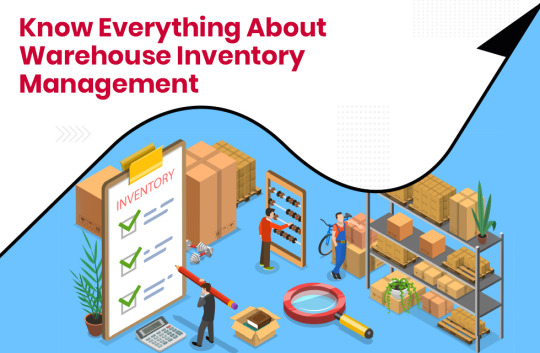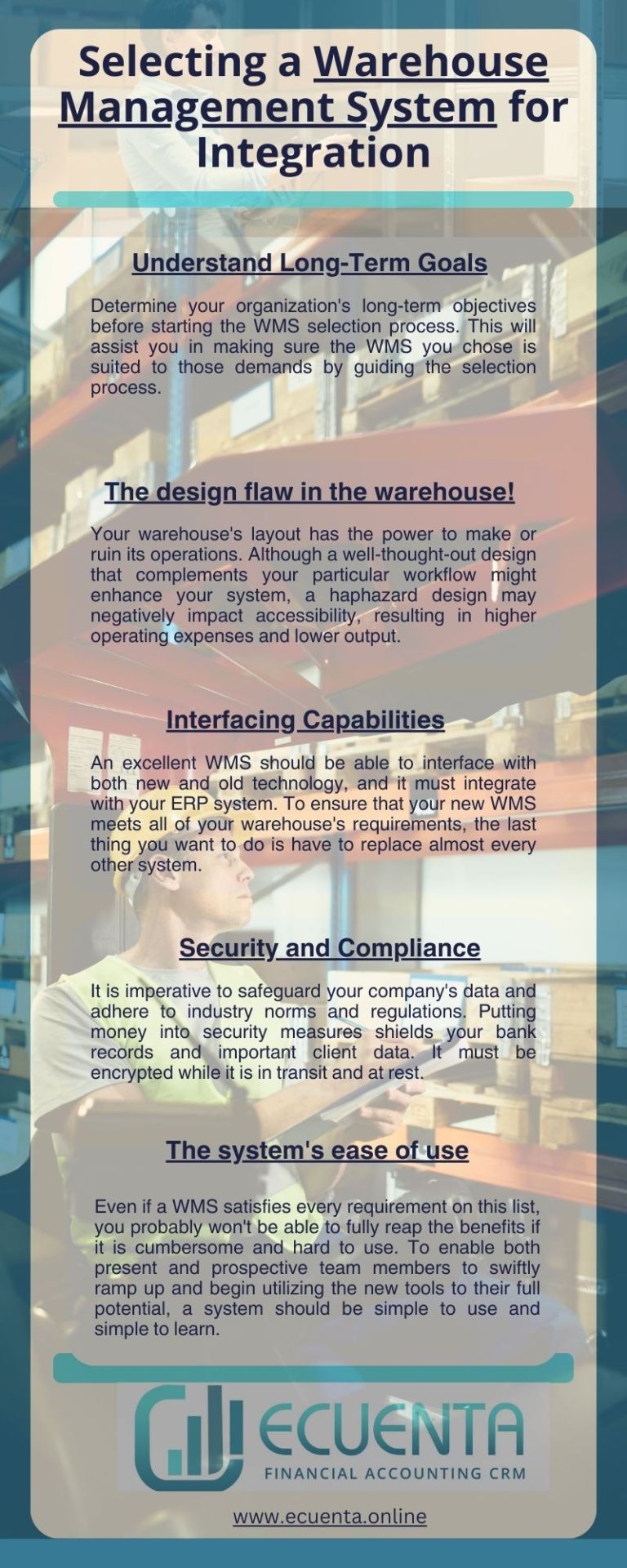#warehouse management system
Photo

Best Warehouse Management Services | Life Care Logistic
Warehouse Management is the process of Managing and tracking the goods in the warehouse to increase the efficiency of the supply chain services. Life Care Logistic Provides you with the Best warehouse Management services in Indore.
#warehouse management system#wms system#best warehouse management system#3pl logistics#3pl in India#Top logistic company in India
3 notes
·
View notes
Text
Looking for Best Inventory Management Software?
Stock management is the practice of ordering, storing, tracking, and controlling inventory. Stock management applies to every item a business uses to produce its products or services – from raw materials to finished goods. In other words, stock management covers every aspect of a business's inventory. So, most of the people also called it as Inventory Management.
Who can use Inventory Management Software: -
Organizations from small to large businesses can make use of inventory management to track their flow of goods. There are numerous inventory management techniques, and using the right one can lead to providing the correct goods at the correct amount, place and time.
Mostly Distributors, Whole sellers, and online stores who are associated with Amazon, Flipkart, eBay, Myntra etc., as a Seller Account. Even a small business also needs Inventory Management System to check their inventory count to sell goods to customers.
Top 5 Inventory Management Software Providers List: -
Zoho Inventory
Oracle NetSuite
Youngminds Inventory Management Software
Cin7
QuickBooks commerce
Compare with all 4 top inventory software’s, “Youngminds” Inventory Management Software is Budget Friendly, User Friendly (Will develop Custom Software and Mobile App Development also as per clients need), Excellent Customer Services. They will give training support to clients - “How to Use Inventory Software in regional languages”.
Youngminds - Inventory Management Software: -
“Young Minds” is a leading Web Design and Software Development Company provides digital solution services for all type of business & industry need. Served more than 1000+ clients from past 7years. Well experienced in handling projects, analyzing customer needs and working together with clients to reach client expectations.

Benefits of YoungMinds Inventory Management Software: -
Centralized Inventory - Inventory management software connects marketplaces, web carts, online stores, offline stores, couriers and more.
Linking Multiple Ware Houses – Able to Link multiple warehouses to our Customized Warehouse Management Software to manage products.
Manage Multiple SKU Codes - The magic of our inventory control software - Calculate order cycle time to ensure your profits by analyzing different cost associated with it.
Un-Mapped SKU Alert - Automatically follow up your product inventory listed - Also get un-mapped alerts for inventory tracking & monitoring.
Bulk Stock Addition - You can add or delete bulk products, categories, SKUs, bundles, aliases, prices and many more.
Sorting - A crucial step of accuracy and customer satisfaction – making sure all ordered items are available and in good condition
"The more inventory a company has, the less likely they will have what they need." - Taiichi Ohno
Automate & Simplify Your Inventory by using our Inventory Management Software
Call / WhatsApp us for any Queries @ +91-8688400282
For more assistance - Visit Website: - https://www.ymtsindia.com/
Inventory Management Software: - https://www.ymtsindia.com/inventory-management-software
#inventory management software#inventory management system#warehouse management software#warehouse management system#stock management software
2 notes
·
View notes
Text
Everything You Need to Know About Warehouse Inventory Management

Managing your inventory and a warehouse is a never-ending process as long as you are running a business. Warehouse Inventory Management (WIM) becomes increasingly time-consuming and expensive as your business expands. The more orders you receive, the more time you will have to replenish your inventory and arrange your warehouse.
Aside from using more effective storage methods and other instruments to decrease manual labor and human error, WIM may also benefit from implementing automation and other methods that assist save expenses.
What is Warehouse Inventory Management (WIM)?
Warehousing and inventory management involves many steps, such as receiving and storing products, managing warehouse workers, and maximizing storage space, all of which directly influence the customer experience.
What are the Benefits of Warehouse Inventory Management for Your Company?
Logistics expenses and supply chain efficiency are directly related to how well you handle inventory in a warehouse. When you think of inventory management at a warehouse, you are likely to think of stocking shelves. For this reason alone, many businesses choose to outsource their inventory and warehouse management to a third-party logistics company, which has a wealth of experience in this area.
LEARN MORE...
3 notes
·
View notes
Text

𝗦𝗮𝘆 𝗚𝗼𝗼𝗱𝗯𝘆𝗲 𝘁𝗼 𝗔𝗰𝗰𝗼𝘂𝗻𝘁𝗶𝗻𝗴 𝗛𝗮𝘀𝘀𝗹𝗲𝘀!
Manage all your financial operations with FULFILLOR, that enables you to integrate a variety of accounting software that suits your business needs.
Connect with us at [email protected] or visit our website at https://bit.ly/fulfillor
0 notes
Text
NetSuite (WMS) Warehouse Management System | NetScore
Technologies NetScore WMS Mobile For NetSuite brings the power of barcode technology to wholesale distribution and manufacturing companies.
https://bit.ly/3xokfkp
#warehouse management solutions#warehouse management system#wms mobile for netsuite#inventory tracking barcode system#barcode scanner for warehouse inventory
0 notes
Text
Streamlining Operations: Exploring the Role of Order Management, Warehouse Management, and Inventory Control Systems
In today's fast-paced business environment, effective management of orders, warehouses, and inventory is crucial for success. Enter the trio of Order Management Systems (OMS), Warehouse Management Systems (WMS), and Inventory Control Systems (ICS). In this blog post, we'll delve into the significance of each system and how they work together to optimize operations and drive business growth.

1. Understanding Order Management Systems (OMS)
An Order Management System (OMS) is a software solution that facilitates the end-to-end processing of orders, from order placement to fulfillment. Key features of an OMS include:
Order Processing: OMS automates order processing tasks such as order entry, validation, and routing, ensuring accuracy and efficiency in order fulfillment.
Inventory Visibility: By providing real-time visibility into inventory levels across multiple locations, OMS enables businesses to fulfill orders from the nearest and most optimal fulfillment center, reducing shipping costs and delivery times.
Order Tracking: OMS allows customers to track the status of their orders in real-time, enhancing transparency and improving the overall customer experience.
2. Unveiling Warehouse Management Systems (WMS)
A Warehouse Management System (WMS) is a software solution designed to optimize warehouse operations and streamline the movement and storage of inventory. Key features of a WMS include:
Inventory Management: WMS provides robust inventory management capabilities, including inventory tracking, lot control, and cycle counting, ensuring accurate inventory records and minimizing stockouts and overstocks.
Optimized Warehouse Layout: WMS helps optimize warehouse layout and storage locations, maximizing space utilization and improving picking and packing efficiency.
Task Automation: WMS automates warehouse tasks such as receiving, put-away, picking, and packing, reducing manual errors and increasing productivity.
3. Harnessing Inventory Control Systems (ICS)
An Inventory Control System (ICS) is a software solution that enables businesses to efficiently manage and control their inventory levels. Key features of an ICS include:
Inventory Tracking: ICS provides real-time visibility into inventory levels, locations, and movements, allowing businesses to track and trace inventory across the supply chain.
Demand Forecasting: ICS utilizes historical sales data and demand forecasting algorithms to predict future demand, helping businesses optimize inventory levels and reduce excess inventory costs.
Stock Replenishment: ICS automates stock replenishment processes, generating purchase orders or production orders based on inventory levels and demand forecasts, ensuring timely replenishment of stock.
Conclusion
In today's competitive marketplace, businesses must leverage advanced technology solutions such as Order Management Systems, Warehouse Management Systems, and Inventory Control Systems to streamline operations, enhance efficiency, and meet customer demands effectively. By implementing and integrating these systems seamlessly, businesses can optimize their supply chain processes, reduce costs, and drive sustainable growth in the long run.
For original post :- https://myvipon.com/post/928786/Streamlining-Exploring-Role-Order-Warehouse-Inventory
0 notes
Text

How to integrate a Warehouse Management System into your business
Effective warehouse management is essential for any aspiring business to succeed. You must know when and how to adopt a warehouse management system (WMS) in addition to how to properly organize your warehouse. To remain competitive in the fast-paced world of business, entrepreneurs must always be at the top of their game.
#warehouse management system#warehouse management systems software#warehouse management software#wms system#wms software
0 notes
Text

How to integrate a Warehouse Management System into your business
Effective warehouse management is essential for any aspiring business to succeed. You must know when and how to adopt a warehouse management system (WMS) in addition to how to properly organize your warehouse. To remain competitive in the fast-paced world of business, entrepreneurs must always be at the top of their game.
#warehouse management system#warehouse management systems software#warehouse management software#wms system#wms software
0 notes
Text
The Benefits of Pick and Pack Solutions for Your Business
Efficient order fulfillment is essential for businesses looking to succeed in today's competitive market. Pick and pack solutions play a crucial role in streamlining the fulfillment process and enhancing customer satisfaction. In this blog post, we'll explore the numerous benefits that pick and pack solutions offer to businesses of all sizes.
Enhanced Efficiency and Accuracy
One of the primary benefits of pick and pack solutions is the enhanced efficiency and accuracy they bring to the order fulfillment process. Instead of manually sorting through inventory and assembling orders, pick and pack systems automate these tasks, reducing the likelihood of errors and speeding up fulfillment times.
Key features and benefits include:
Barcode Scanning: Pick and pack solutions utilize barcode scanning technology to accurately pick items from inventory and pack them for shipping. This minimizes picking errors and ensures the right products are included in each order.
Optimized Workflows: Pick and pack systems optimize warehouse workflows by organizing orders based on factors like order size, destination, and shipping method. This streamlines the picking and packing process, leading to faster order processing times.
Real-Time Inventory Updates: With pick and pack solutions, inventory levels are updated in real-time as orders are fulfilled. This visibility into inventory levels helps prevent stockouts and enables better inventory management.
By improving efficiency and accuracy, pick and pack solutions contribute to overall operational excellence and customer satisfaction.
Scalability and Cost Efficiency
Another significant benefit of pick and pack solutions is their scalability and cost efficiency. Whether your business experiences seasonal fluctuations in demand or steady growth, pick and pack systems can adapt to varying order volumes without compromising on efficiency or incurring significant overhead costs.
Key advantages include:
Scalable Infrastructure: Pick and pack solutions can scale up or down based on demand, allowing businesses to handle increased order volumes during peak seasons without overburdening their resources.
Reduced Labor Costs: Automation and optimized workflows reduce the need for manual labor in the order fulfillment process. This leads to lower labor costs and allows employees to focus on higher-value tasks.
Faster Order Processing: The streamlined workflows enabled by pick and pack solutions result in faster order processing and shipping times. This, in turn, leads to improved customer satisfaction and repeat business.
The scalability and cost efficiency of pick and pack solutions make them a valuable asset for businesses looking to grow and adapt to changing market conditions.
Conclusion
Pick and pack solutions offer a range of benefits, including enhanced efficiency, accuracy, scalability, and cost efficiency, making them indispensable for businesses striving to optimize their order fulfillment processes. If you're looking to improve your business's operations and customer satisfaction, consider implementing a pick and pack solution tailored to your specific needs
For more details please visit: https://warehouse2anywhere.com.au/
Contact Us
Warehouse 2 Anywhere
68-72 York Street South Melbourne
VIC 3205
Phone No: +61 3 7037 6525
Support: [email protected]
Sales: [email protected]
0 notes
Text
In today's fast-paced business landscape, an efficient warehouse management system (WMS) is crucial for streamlining operations, reducing costs, and maintaining a competitive edge. However, as technology evolves and business needs change, your existing WMS may become outdated, leading to inefficiencies and potential bottlenecks.
0 notes
Text
youtube
NEC Mi-WareSync is a software platform acting as a catalyst for innovation in logistics & supply chain, playing a pivotal role in the evolution of smart logistics.
#NEC Mi-WareSync#Warehouse Management System#necindia#poweringbilliondreams#70yearsofpoweringindia#necpoweringindia#Youtube
0 notes
Text
Best Value Added Services | Life Care Logistic
Life Care Logistic is one of the Top logistics companies in Indore provides the best value-added services for products. Our logistic services are completely handled by a professional team. Life Care Logistic is the Best Logistic Company in India.
#3pl service provider#3pl logistics#3pl services#3PL#warehouse management system#Best Warehouse Management System
3 notes
·
View notes
Text
Maximising Space with AWL India's Warehouse Management Service
Discover the art of maximizing storage capacity and efficiency with our Warehouse Management Service. Optimise warehouse space, and boost productivity and profit. From smart layouts to innovative space-saving techniques, we've got you covered. To know more, visit our website - https://www.awlindia.com/warehousing
#warehouse services in pune#warehouse service providers in delhi#warehouse management system#warehouse management process#warehouse management#warehouse in delhi for rent#warehouse for rent in lucknow#warehouse for rent in hyderabad#smart warehouse management system#cross docking & warehouse services#best warehouse company in india#AWL India
0 notes
Text
𝗘𝗹𝗶𝗺𝗶𝗻𝗮𝘁𝗲 𝘁𝗵𝗲 𝗺𝗮𝗻𝘂𝗮𝗹 𝗽𝗿𝗼𝗰𝗲𝘀𝘀𝗲𝘀 𝗮𝗻𝗱 𝘀𝘁𝗿𝗲𝗮𝗺𝗹𝗶𝗻𝗲 𝘆𝗼𝘂𝗿 𝗯𝘂𝘀𝗶𝗻𝗲𝘀𝘀 𝗼𝗽𝗲𝗿𝗮𝘁𝗶𝗼𝗻𝘀 𝘄𝗶𝘁𝗵 𝗮𝘂𝘁𝗼𝗺𝗮𝘁𝗲𝗱 𝘄𝗼𝗿𝗸𝗳𝗹𝗼𝘄𝘀.
Book a demo or connect with us at [email protected] to revolutionize your business today!
#OrderManagementSystem#OMS#Fulfillor#InventoryManagement#OrderManagement#ShippingSolutions#Shipping#LogisticsManagement#Logistics





#order management system#warehousesystem#inventory software#inventorymanagement#warehouse management system
0 notes
Text
Streamlining Operations: The Power of Order Management Systems and Warehouse Management Systems
In the dynamic world of modern business, effective management of orders, inventory, and warehouses is essential for success. This blog explores the pivotal role of Order Management Systems (OMS) and Warehouse Management Systems (WMS) in optimizing operations and driving efficiency.

1. Understanding Order Management Systems (OMS)
Efficient Order Processing: An Order Management System (OMS) serves as the central hub for managing and processing orders from various sales channels. It streamlines the entire order lifecycle, from order placement to fulfillment, invoicing, and shipment tracking. With an OMS in place, businesses can automate order processing tasks, minimize errors, and ensure timely fulfillment.

Enhanced Customer Experience: A robust OMS enables businesses to provide an exceptional customer experience by ensuring accurate order fulfillment, real-time order tracking, and seamless communication throughout the order journey. By delivering orders promptly and accurately, businesses can build trust and loyalty among their customer base.
2. Harnessing the Power of Warehouse Management Systems (WMS)
Optimized Inventory Management: A Warehouse Management System (WMS) is instrumental in optimizing inventory management within warehouses or distribution centers. It provides real-time visibility into inventory levels, locations, and movement, allowing businesses to efficiently manage stock levels, reduce carrying costs, and prevent stockouts or overstock situations.
Streamlined Operations: WMS software automates and streamlines warehouse operations, including receiving, put-away, picking, packing, and shipping. By optimizing workflows and utilizing features such as barcode scanning and RFID technology, WMS solutions help improve accuracy, productivity, and overall operational efficiency.
3. Importance of Inventory Control Systems
Accurate Inventory Tracking: Inventory Control System are crucial for accurate tracking and management of inventory across multiple locations. These systems utilize advanced tracking technologies to monitor stock levels, track inventory movements, and reconcile inventory discrepancies in real-time. By maintaining accurate inventory records, businesses can prevent stockouts, minimize excess inventory, and improve inventory turnover ratios.
Effective Demand Planning: Inventory Control Systems enable businesses to analyze historical sales data, forecast demand, and plan inventory replenishment cycles more effectively. By identifying trends, seasonality, and demand patterns, businesses can optimize inventory levels, reduce carrying costs, and ensure product availability to meet customer demand.
Conclusion: Empowering Efficiency Through OMS, WMS, and Inventory Control
In conclusion, Order Management Systems (OMS), Warehouse Management Systems (WMS), and Inventory Control Systems play pivotal roles in streamlining operations, optimizing inventory management, and enhancing customer satisfaction. By investing in these advanced systems, businesses can streamline workflows, improve accuracy, and stay competitive in today's fast-paced business environment. Embrace the power of OMS, WMS, and Inventory Control Systems to drive efficiency and success in your operations.
For original post :- https://myvipon.com/post/921970/Streamlining-The-Power-Order-Management-Systems-amazon-coupons
0 notes
Text
How to integrate a Warehouse Management System into your business
Effective warehouse management is essential for any aspiring business to succeed. You must know when and how to adopt a warehouse management system (WMS) in addition to how to properly organize your warehouse. To remain competitive in the fast-paced world of business, entrepreneurs must always be at the top of their game. An essential component that is impossible to ignore is effective storage. Your supply chain's success ultimately depends on it. But have no fear a state-of-the-art warehouse management system is the easy fix.
Because business is becoming more and more globalized, logistics is becoming a vital and expanding industry. Businesses are searching for trustworthy partners to assist them in maintaining their supply chains as they keep entering new markets. Amidst all of this, logistics companies are dealing with several opportunities as well as obstacles, which they are addressing with the help of various digital technologies. Specifically, we'll examine specialized warehouse inventory software and how it might provide you with an advantage in the market.

What is a Warehouse Management System?
Software that oversees activities in a warehouse is called a warehouse management system. Warehouse operations including inventory control, order fulfilment, transportation management, and labour management are coordinated, automated, and optimized with its assistance.
You can maximize space consumption and optimize your warehouse resources with an efficient WMS. Furthermore, warehouse management software helps the organization by significantly reducing material movement time with sufficient investment in the equipment. Consequently, this raises the warehouse's efficiency.
Warehouse management solutions have the potential to lower mistakes, boost accuracy, and boost overall productivity. Through the use of technology, WMSs can streamline order fulfilment by automating manual procedures, improve inventory control by precisely tracking stock levels, and lower personnel costs related to labour-intensive tasks like sorting and packing goods.
What does a Warehouse Management System do?
The size and prominence of the company influence the design of just a small number of warehouse management systems. In others, additional components are part of the consideration parameters. Different WMS product versions that can be scaled to different organizational sizes are used by vendors. In certain instances, a small number of organizations have thought about creating their own WMS, even though it is recommended that they use one from a reputable provider.
Pen and paper were largely replaced by barcode scanners and handheld devices in the first WMS warehouse management systems, which were basically computerized versions of manual systems. However, these days, many software solutions make use of automation. The inventory warehouse management software can also be integrated with other company systems, including supply chain management (SCM) and enterprise resource planning (ERP) systems. This boosts productivity and lowers errors by enabling real-time data sharing between systems.
Selecting a Warehouse Management System for Integration:
Understand Long-Term Goals
The design flaw in the warehouse!
Assessing the Difficulties and Present Warehousing Procedures
Interfacing Capabilities
Security and Compliance
The system's ease of use
Data and analytics in real-time
Understand Long-Term Goals:
Determine your organization's long-term objectives before starting the WMS selection process. This will assist you in making sure the WMS you chose is suited to those demands by guiding the selection process. Objectives may be tied to particular KPIs and metrics, or they may simply be centred around your desire to handle a greater range of higher inventory visibility.
The design flaw in the warehouse:
Your warehouse's layout has the power to make or ruin its operations. Although a well-thought-out design that complements your particular workflow might enhance your system, a haphazard design may negatively impact accessibility, resulting in higher operating expenses and lower output.
Assessing the Difficulties and Present Warehousing Procedures:
Start by outlining your regular procedures. Recognize any areas where manual processes may be causing inefficiency or frequent bottlenecks. Order fulfilment timelines may be taking longer than expected, or inventory management may be difficult. Gaining a comprehensive understanding of these issues will help you make sure that the WMS solution you select is specifically designed to tackle these particular problems.
Interfacing Capabilities:
An excellent WMS should be able to interface with both new and old technology, and it must integrate with your ERP system. To ensure that your new WMS meets all of your warehouse's requirements, the last thing you want to do is have to replace almost every other system.
Security and Compliance:
It is imperative to safeguard your company's data and adhere to industry norms and regulations. Putting money into security measures shields your bank records and important client data. It must be encrypted while it is in transit and at rest. To find vulnerabilities and guarantee continuous compliance, periodic security audits and assessments can be helpful.
The system's ease of use:
Even if a WMS satisfies every requirement on this list, you probably won't be able to fully reap the benefits if it is cumbersome and hard to use. To enable both present and prospective team members to swiftly ramp up and begin utilizing the new tools to their full potential, a system should be simple to use and simple to learn. Replicating past tasks is insufficient if you want your management, IT, and operations teams to get the most out of every WMS feature and optimize results.
Data and analytics in real-time:
Real-time data and analytics must be accessible to promote ongoing development and educate decision-making. With the wealth of information a WMS provides you with regarding your employees, processes, and inventory, you can spot trends, identify inefficiencies, and monitor the effectiveness of your warehouse. With this knowledge at hand, you can make well-informed decisions that improve your warehouse operations.
Successful Implementations of Warehouse Management Systems:
The development of the Internet and digitization has had a significant impact on consumers' purchasing behaviours. Customers want the guarantee of hassle-free returns, quick delivery, and the ability to shop from their "place" of convenience. This translates into an increase in the number of companies using warehouse management systems and implementing WMS. Retail organizations can benefit from a strong warehouse management system (WMS) to meet customer expectations in light of these new behaviors that have disrupted the fulfilment process. Inadequate WMS system installation can lead to more issues than it solves, including stock loss, erroneous inventory counts, and extended shipment times.
By using a warehouse management system, a company can make sure that sales channels, inventory data, and financials are updated regularly with every shipment, delivery, and warehouse transfer. Thorough planning before, during, and following implementation will guarantee the success of the WMS installation. For the WMS installation to be successful, the customer and the WMS vendor need to work together as a cohesive team.
Making the right choice:
It's important to carefully analyze your business goals, functionality requirements, and future business growth while selecting the correct WMS solution. The best WMS system will enable improved inventory and order management as well as ongoing system management, allowing your business to concentrate on what matters creating a remarkable customer experience for every one of your customers.
#warehouse management system#warehouse management software#wms system#wms software#inventory management software
0 notes